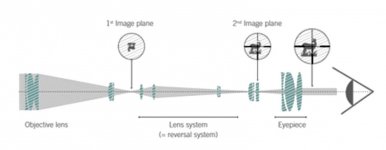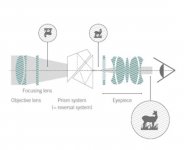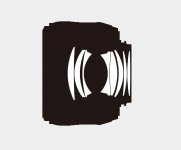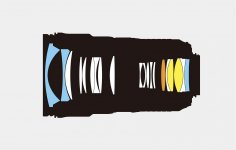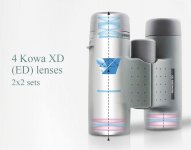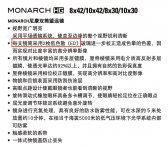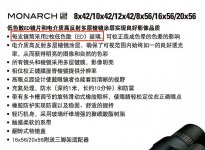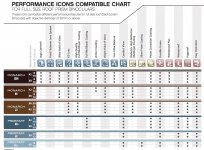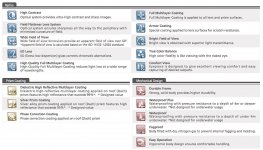By way of context, binoculars are much simpler in terms of optical construction than many quality camera lenses
The difference is especially striking when one considers that a camera lens only performs a small portion of the optical functions of a binocular
See two optical diagrams from Swarovski:
• the first shows a telescopic sight (a form of terrestrial telescope), where a camera lens would only comprise the objective portion
(in a camera, the image is then projected on to the digital sensor or film emulsion while both inverted and reversed, and focusing is achieved by moving elements in the lens)
• the second shows a binocular, where the objective group in conjunction with the prisms brings the correctly orientated image to a focal point,
and the eyepiece group then magnifies the image
(the focuser is part of the objective group, the use of prisms enable a shorter length, and many binoculars have less than the 6 lenses shown in the eyepiece)
In contrast, compare the images of two Nikon 35mm format lenses:
- firstly, a relatively simple 50mm f/1.4 lens, with 8 elements in 7 groups, and
- a much more complex 24-70mm f/2.8 VR lens, with 20 elements in 16 groups; with 2 ED lenses indicated in yellow, 3 aspherical elements in blue and 1 aspheric ED element in orange!
- - - -
Binoculars are optically much simpler, both in terms of construction and glass composition, because the image quality required from them is much less
We use them to view in real time an object that is often in motion, often subject to atmospheric conditions, and often while we are holding the binocular without any additional support
In contrast, a static photographically recorded image is often scrutinised at length. And the image may be vastly enlarged to analyse the technical qualities of the image,
and the lens that took the image
So the image quality demands are often very much higher
- - - -
In terms of public awareness, Nikon started to use ED glass in some 35mm format telephoto camera lenses in the early 1970’s
However, the use in binoculars is a recent innovation. It was first officially used by Zeiss in 2004 with the introduction of the Victory FL line,
by Leica in 2007 with the introduction of the Ultravid HD line, by Swarovski in 2010 with the introduction with the EL SV line and also by Nikon in 2010 with the EDG introduction
Typically it’s used for 1 of the elements of the main objective group. However, some makers do use it for 2 elements e.g. in the Kowa Genesis XD models
(Often Nikon does not provide details about the optical construction of their binoculars, and I've not seen any detail about the current HG's)
As moyang_mm indicates, for descriptions of the effect of ED glass on chromatic aberration in particular models, see Roger Vine's set of reviews
at:
http://www.scopeviews.co.uk/BinoReviews.htm
In each there is a section on CA, and the reviews include the Kowa 8x33 and 10.5x44, along with the Nikon HG 10x42
And for comparison, note the minimal CA in the Habicht 10x40 Porro that lacks any ED glass!
Finally, the degree to which the presence of CA is perceived as disturbing, varies greatly between individuals
If one's relatively insensitive then other considerations will matter much more when choosing a binocular
John





